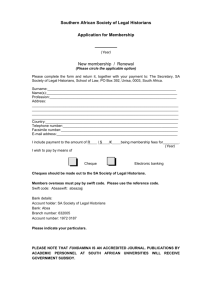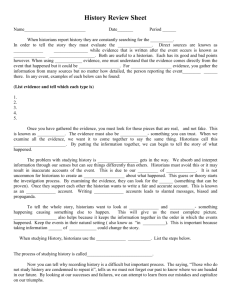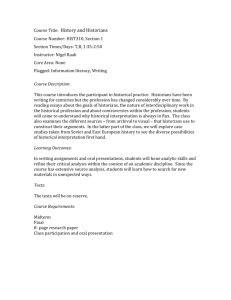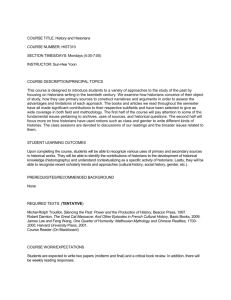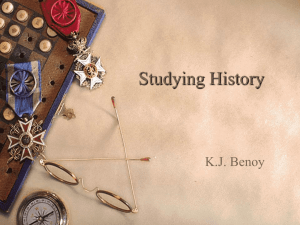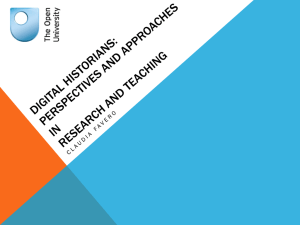DESIGN DOCUMENT: US 23 HERITAGE VIDEOS
advertisement
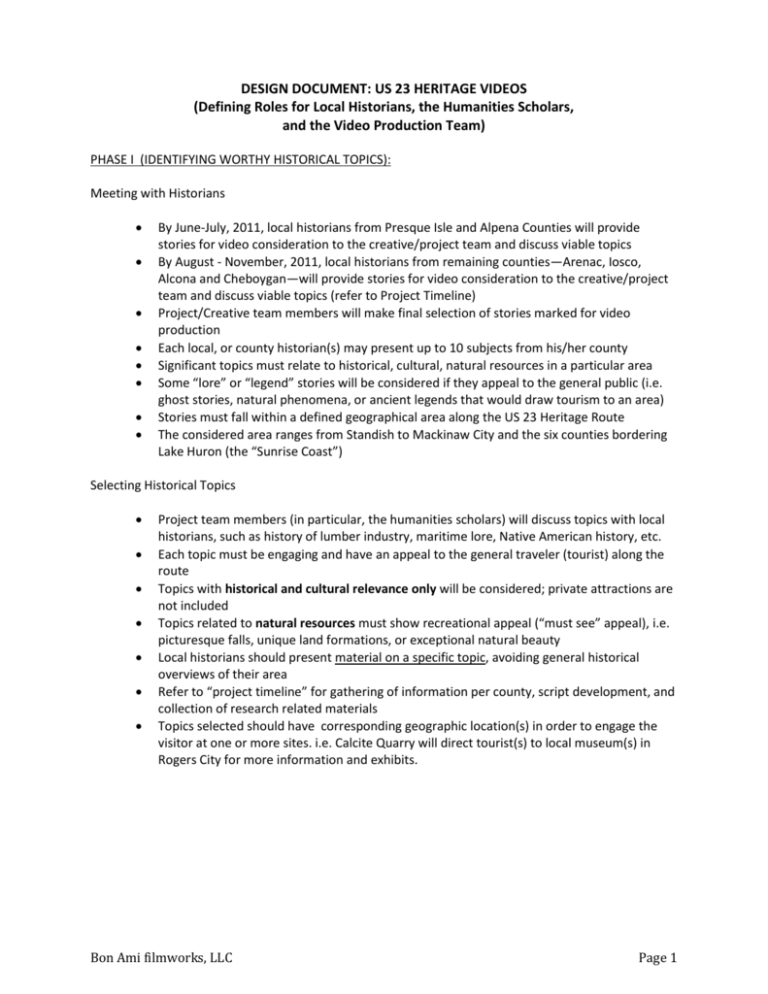
DESIGN DOCUMENT: US 23 HERITAGE VIDEOS (Defining Roles for Local Historians, the Humanities Scholars, and the Video Production Team) PHASE I (IDENTIFYING WORTHY HISTORICAL TOPICS): Meeting with Historians By June-July, 2011, local historians from Presque Isle and Alpena Counties will provide stories for video consideration to the creative/project team and discuss viable topics By August - November, 2011, local historians from remaining counties—Arenac, Iosco, Alcona and Cheboygan—will provide stories for video consideration to the creative/project team and discuss viable topics (refer to Project Timeline) Project/Creative team members will make final selection of stories marked for video production Each local, or county historian(s) may present up to 10 subjects from his/her county Significant topics must relate to historical, cultural, natural resources in a particular area Some “lore” or “legend” stories will be considered if they appeal to the general public (i.e. ghost stories, natural phenomena, or ancient legends that would draw tourism to an area) Stories must fall within a defined geographical area along the US 23 Heritage Route The considered area ranges from Standish to Mackinaw City and the six counties bordering Lake Huron (the “Sunrise Coast”) Selecting Historical Topics Project team members (in particular, the humanities scholars) will discuss topics with local historians, such as history of lumber industry, maritime lore, Native American history, etc. Each topic must be engaging and have an appeal to the general traveler (tourist) along the route Topics with historical and cultural relevance only will be considered; private attractions are not included Topics related to natural resources must show recreational appeal (“must see” appeal), i.e. picturesque falls, unique land formations, or exceptional natural beauty Local historians should present material on a specific topic, avoiding general historical overviews of their area Refer to “project timeline” for gathering of information per county, script development, and collection of research related materials Topics selected should have corresponding geographic location(s) in order to engage the visitor at one or more sites. i.e. Calcite Quarry will direct tourist(s) to local museum(s) in Rogers City for more information and exhibits. Bon Ami filmworks, LLC Page 1 Selecting and Working with Local Historians Information provided by each historian must be concise, brief, and well organized, or must be summarized by the historian so that the humanities scholars and project/creative team can make an informed decision Each topic, or story, must be authenticated (corroborated by at least a second source) or by a humanities scholar Exception to above: legends and lore; however, stories must have cultural and historical significance or shown to have existed for many years (have veracity) Above all, topics must have visual appeal: archive photos and/or movies, historical drawings, woodcarvings, paintings, sculptures, natural formations, existing structures or buildings, etc. Whenever possible, historians must provide access to archive material listed above for digital scanning or digital photography, grant permission to use the material, and provide assurance that the project/creative team is free and clear to use the archive material Historians and project/creative team members will work together to garner additional historical resources, including rights to film or photograph areas that may be near, or on, private land PHASE II (WRITING & PRODUCING VIDEOS OR “MINI-DOCUMENTARIES”) HD Digital Production Selected topics (from “history”, “cultural”, “natural resource”, “legend/lore” aspects) will be developed into video production scripts, approved by the project/creative team, and vetted for historical accuracy by the humanities scholars If occasion warrants, video production scripts will be sent to local historians for verification Stories selected for video production will be acquired in High Definition Each video will be approximately 3-6 minutes in length Each video will use strong visuals, professional narration and music Videos will be available for viewing to the general public on the website Videos will be available for viewing to the general public on SmartPhones using QR Codes displayed on or in Mileposts, signage, brochures, and booklets Videos will be available through a free application on SmartPhone platforms such as Android and iPhone GENERAL OVERVIEW OF PROCESS 1. Select historians. 2. Historians gather local stories according to criteria established. 3. Humanities scholars and project team review stories and select stories for video (remaining stories are told in written/photo form on website and in print media). 4. Historians and project team gather additional historical resources and rights to film/photograph. 5. Production of videos and print media. Bon Ami filmworks, LLC Page 2


